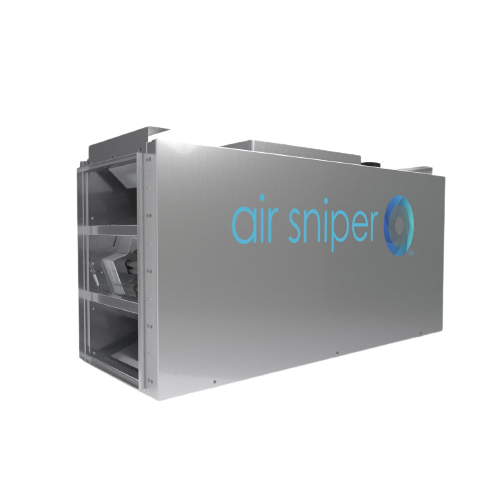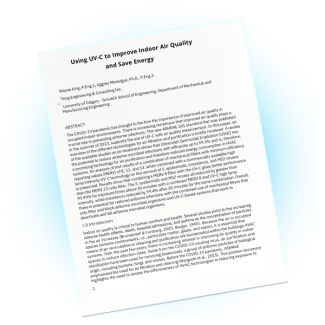Commercial buildings are a large category of real estate. They include the spaces where business and commerce occur, but they also encapsulate large public spaces like malls, airports, and more. Though it is hard to think of all the different kinds of commercial buildings, it is not nearly so difficult to think of something they all have in common.
What Commercial Buildings Have in Common?
Indeed, all commercial buildings require HVAC systems and air cycling equipment. This helps prevent stale air pockets and is an integral part of all architectural design. One part of these systems that is often overlooked is the filtering system.
In most commercial facilities, air filters are made of replaceable random-fiber matting, which catches and traps harmful airborne contaminants. Unlike commercial UVC sanitization, random-fiber matting simply holds these microorganisms in place rather than eradicating them.
How Commercial Buildings Get Commercial Sanitization?
So what can commercial buildings do to get the same level of supplemental air sanitization that they put into their businesses? One solution is commercial UVC sanitizing, which uses the antimicrobial effect of shortwave UV rays to disrupt the DNA of microorganisms, destroying them. The power of this technology is hard to overstate.
What Can UVC Sanitizing Do?
Independent laboratory testing has proven the efficacy of UVC sanitization multiple times. These supplementary air sanitization units have reduced the concentration of harmful microorganisms significantly, and the results show that the technology is capable of protecting from airborne contaminants.
Benefits of UVC commercial disinfection:
- Effective germ elimination. UVC light has been shown to effectively deactivate and eliminate a wide range of harmful microorganisms, including bacteria, viruses, and mold spores.
- Chemical-free. UVC commercial sanitizing does not require the use of chemicals, making it a safer and environmentally friendly sanitization method.
- Rapid disinfection. UVC light can achieve rapid disinfection, often within seconds to minutes, depending on the intensity of the light and the duration of exposure.
- Non-toxic. Unlike chemical disinfectants, UVC light does not leave behind any toxic residues, making it safe for use in various settings, including food preparation areas and healthcare facilities.
- Versatile application. UVC commercial sanitizing can be used to disinfect various surfaces and objects, such as countertops, medical equipment, electronic devices, and even air and water.
- Continuous operation. UVC sanitizing systems can operate continuously, providing ongoing disinfection in spaces where cleanliness is critical, such as hospitals, laboratories, and cleanrooms.
UVC commercial sanitizing offers a highly effective, chemical-free, and versatile solution for disinfecting surfaces and ensuring a safer environment for various applications.
The Difference Between Cleaning and Disinfecting
There are important distinctions between cleaning and disinfecting or sanitizing. Although surfaces may look clean on the outside, they do not necessarily have to be hygienic.
Cleaning works to remove germs and dirt at the surface level however sanitizing works to ensure the germs are killed to reduce the spread of infection.
While thorough cleaning can be effective at decreasing the spread of infection, fully disinfecting areas with chemicals can decrease the risk even more.
The effectiveness of cleaning and disinfection hinges on the correct application of disinfectant cleaners, which are chemicals scientifically proven to eradicate harmful microbes.
Manual disinfection techniques, such as wiping surfaces with disinfectant solutions, are commonly employed in high-risk sectors like healthcare, food processing, and public spaces. Additionally, natural disinfectants such as alcohol, hydrogen peroxide, vinegar, and hot water can serve as viable alternatives to chemical cleaners, although they may necessitate longer exposure times for full effectiveness.
Using these cleaners properly can foster a safer environment for all within your facility. It’s essential to adhere to the provided instructions for each product, as this ensures their optimal efficacy and safety. Providing proper training for staff members on the correct usage of these products is also vital for upholding a hygienic environment. The best solution remains commercial sanitization.
Stages of Commercial Sanitization
Here are the stages of commercial sanitization:
- Assessment. The first step involves assessing the commercial space to identify high-touch areas, potential sources of contamination, and specific sanitation requirements.
- Preparation. This stage involves preparing the area for sanitization by removing any clutter, debris, or obstacles that may hinder the disinfection process. It may also involve covering or protecting sensitive equipment or materials.
- Cleaning. Before sanitization, surfaces should be cleaned to remove visible dirt, grime, and organic matter. This helps improve the effectiveness of the sanitization process by allowing the disinfectant to make direct contact with the surface.
- Application of disinfectant. The next step is to apply an appropriate disinfectant to the surfaces using recommended methods such as spraying, wiping, or fogging. It must be applied evenly and allowed to stand for the specified contact time to ensure the effective killing of germs.
- Dwell time. Dwell time refers to the duration that the disinfectant needs to remain on the surface to effectively kill germs. It is essential to follow the manufacturer’s instructions regarding dwell time for optimal results.
- Wiping or rinsing. Depending on the type of disinfectant used, surfaces may need to be wiped down or rinsed after the specified dwell time to remove any residue or excess disinfectant.
- Drying. Allow the surfaces to air dry or use appropriate drying methods to ensure that they are completely dry before allowing access to the sanitized area.
- Quality check. After sanitization, it is essential to conduct quality checks to ensure that all high-touch areas and critical surfaces have been adequately sanitized. This may involve visual inspections or using ATP testing to measure residual contamination levels.
- Documentation. Finally, it is crucial to document the sanitization process, including the disinfectants used, contact times, areas sanitized, and any corrective actions taken.
By following these stages of commercial sanitization diligently, businesses can effectively mitigate the risk of infection and create a safer environment for employees, customers, and visitors.
Determining Cleaning and Disinfection Frequency
Commercial sanitizing should ideally be done regularly, with the frequency depending on factors such as the type of facility, level of foot traffic, and specific sanitation requirements. However, a common recommendation is to sanitize commercial spaces at least once a day, particularly focusing on frequently touched surfaces and high-traffic areas.
Commercial Sanitization by Air Sniper in Canada
Air Sniper disinfection service caters to businesses operating in sectors with high foot traffic, aiming to safeguard the health and safety of both employees and patrons. Air Sniper disinfection services are particularly suitable for the following industries:
- Education (including schools, daycares, universities, and colleges).
- Fitness & recreation (such as gyms, locker rooms, and sports arenas/facilities).
- Healthcare (encompassing hospitals, long-term care homes, veterinary facilities, ambulances, and laboratories).
- Foodservice (covering restaurants ranging from fast food to fine dining, as well as brasseries, bistros, and cafes).
- Food processing (including federally inspected meat and poultry processing plants, egg processing facilities, hatcheries, and swine premise sanitation).
- Transportation (spanning airplanes, trains, trucks, buses, and automobiles).
These are just a selection of the numerous industries that could benefit from Air Sniper’s professional-grade disinfection service.
Where to Find Commercial Supplementary Air Sanitization Units?
Air Sniper provides supplementary air sanitization units for commercial buildings of all sizes. They have stand-alone units, which feature easy-to-use plug-and-play technology. Additionally, they carry in-line units, which can fit onto existing HVAC systems with ease. Plus, they are designed for success.
Air Sniper units are built with four key concepts in mind. These are intensity, proximity, and dwell time relative to CFM. Intensity refers to the bulb’s brightness and ability to produce UVC light. Proximity is the closeness of each bulb, maximizing the effective range for the equipment. Dwell time and CFM work together to measure how long air contaminants are exposed to germicidal radiation.
These elements, when combined correctly, improve the results of supplemental commercial sanitization equipment and launch it ahead of competitors. With a simple, sleek, and attractive design, Air Sniper has put the necessary research and testing into their technology, ensuring its effectiveness.
Need quality commercial sanitization in Canada? Contact us today by calling at 1-888-338-9549.



